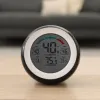There’s a simple answer to this question. You should use an air cleaning system because it makes your air fresher and healthier to breathe.
But you’re not looking for simple answers, are you?
Any time Atlanta homeowners ask us about an air cleaning system, we do our best to go over the proper order of operations for improving your home’s air quality. The way we see it, an “air cleaning system” consists of multiple components: filtration, fresh air, and humidity control.
The more complicated (but more valuable) answer to the air cleaning question is that the unique conditions of your home and your health will dictate how you proceed. That being said, here’s the most ideal order of operations for optimizing air quality.
When possible, invest in air sealing first.
Do you know how a lot of indoor pollutants get into your home? While there are many potential sources, the air leaks between your living space and whatever is above you (attic) and below you (crawlspace) are major entry points for bothersome, allergy-aggravating particulates.
We’ve discussed air leaks on this blog before. Basically, due to the way air circulates inside closed structures, such as your home, air from higher and lower areas tends to infiltrate the part in the middle. Unfortunately, that air is rarely high quality. Your attic is dusty and likely full of fiberglass fibers. Your crawlspace likely harbors pests and microbial growth.
By sealing the gaps and cracks around plumbing, electrical, and HVAC penetrations, you can eliminate most entry points for that dirty air.
When it’s within your budget, we recommend sealing these air gaps before purchasing indoor air quality products. Sure, those products will still help even if you don’t invest in air sealing. But they’ll be even more effective if you prevent the most contaminated air from entering your home in the first place.
Get a better filter
Most people use high-MERV 1″ pleated air filters. While the ability of these filters to make your air cleaner varies significantly from filter to filter, nearly all of them have a big downside: airflow reduction.
Since the filter is relatively small and dense, it reduces the amount of air (cubic feet per minute, or CFM) your HVAC system can move. As a result, the system has to work harder. You end up with reduced efficiency, higher bills, and an HVAC system that doesn’t last as long as it may have otherwise.
That’s why we recommend media filters instead! They provide a high level of filtration (MERV 11 to 16, depending on the model); however, due to the increased surface area compared to 1″ filters and proper sizing for your duct system and HVAC equipment, they don’t restrict airflow.
Media filters give you a high level of filtration without creating airflow issues that increase the infiltration of unclean air. Oh, and you only have to replace them once or twice each year.
What about a HEPA filter?
While we’re on the subject of filtration, let’s talk HEPA filter systems. HEPA (high-efficiency particulate arresting) filters are serious business. If you have serious allergies or are sensitive to certain odors or particulates, these systems package medical-grade air filtration into a system that interfaces with your ductwork.
It’s not just a filter. There are layers of filtration, and the systems even come with their fan that pushes air through the dense filter media.
If you need the best air filter on the market to effectively capture allergens and control odors in your home, a HEPA filter coupled with a media filter is the way to go. And if you’re unable or unwilling to invest in air sealing but still want to improve air quality, a HEPA filter system can be a solid alternative.
Bring in fresh air
We’re not talking about opening windows. We’re talking about regularly replacing the “old” air in your home with fresh, filtered air. How do you do that?
Well, there are two ways. In our humid climate, a whole-house dehumidifier with a fresh air intake is a great way to bring in the fresh air. Not only is the air filtered (there’s a filter inside the dehumidifier); the reduced humidity from the dehumidification process reduces the volume of allergens in the air (more on that in a bit).
This method is called “positive pressure” ventilation. You’re pushing “new” air into the home, positively pressurizing the space. Another good way to bring fresh air into your home is via “balanced” ventilation. With this setup, a piece of equipment called an ERV (energy recovery ventilator):
- Expels air from your home
- Simultaneously brings in an equal amount of air from the outdoors
- Filters the air
- Transfers humidity from one flow of air to another, so you reduce indoor humidity during summer and maintain it in winter
With either method, you’re constantly removing stale, contaminated (or potentially contaminated) air from your home and replacing it with fresh, filtered air that also has a lower moisture content.
Control humidity
For most of the year in our climate zone, the air is very humid. When humid air accumulates inside your home, it encourages the proliferation of allergens: mold and dust mites, in particular. If you’re an allergy sufferer, you want to reduce the amounts of these contaminants to an absolute minimum.
As mentioned previously, installing a whole-house dehumidifier effectively addresses this problem. Even in the absence of a whole-house dehumidifier, air sealing can cut off the entry points for humid air. But there’s another way to lower indoor humidity, too.
If you’re already planning to replace your HVAC system, consider a model with a variable speed compressor. These models run for longer cycles (but at slower speeds) than standard air conditioners. As a result, they do a much better job of reducing humidity. You may still need a dehumidifier during shoulder seasons – think April and October – when it’s still humid but you’re not running the AC.
And while we have short winters here, the dry winter air can still take a toll on indoor comfort. Once again, air sealing helps keep more moisture in your home by minimizing infiltration from the dry outdoors. But when the wintertime dryness is still making you uncomfortable, a whole-house humidifier can add enough moisture to provide relief.
We recommend steam humidifiers. Unlike humidifiers that use hot air from your furnace to create water vapor, these units have a dedicated boiler. They’re more efficient and generally more reliable.
That’s how to create an effectiveair-cleaningg system.
Filter + fresh air + humidity control = outstanding indoor air quality. Oh, and it’s a good idea to air-seal before doing any of that stuff.
If you live in metro Atlanta and are looking for ways to improve air quality in your home, give us a call! We’ll listen to your concerns and point you to the best possible solutions for making your home’s air healthy and clean.






